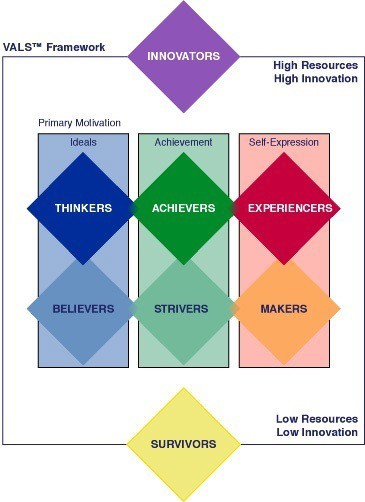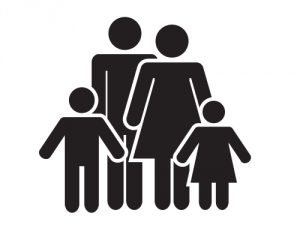
Psychographic segmentation involves separating your target market based on different personality traits, values, attitudes, interests and lifestyles. These can be broken up in many different ways and categorised to help marketers target very niche and specific audiences.
VALs is a model which shows what type of people there are based on Values, Attitudes and Lifestyles. There are many different models that can be used depending on the information that you’re looking for, but this is a pretty solid place to start.

VALs Broken Down
Innovators
High income and high resource individuals, independence is really important to these people. They have your own individual taste and are motivated in achieving the finer things.

Thinkers
These people are well-educated professionals. These people have lots of resources and are motivated by their knowledge. These types of consumers are rational decision makers who are well informed about their surroundings. These consumers are likely to accept any manner of social change due to their knowledge level.

Believers
There is a very subtle difference between thinkers and believers, and this is that thinkers make their own decisions based off of knowledge and believers are more social in nature, making them more likely to believe what other consumers think and feel. Believers have lower resources and are less likely to accept innovation on their own.

Achievers
People who are driven by achievements. These are people who want to excel in all aspects of their life including their job and family. These people are more likely to make a purchase from a successful brand. These types of people have high resources but they are more likely to take on a brand that is rising faster.

Strivers
Strivers are a low resource consumer group which wants to reach some sort of achievement. These people don’t have the resources to be an achiever but they have the same values. If a striver can gain the necessary resources such as high income or social status they can then move on to being an achiever.

Experiencers
Consumers with high resources but also need to be able to express themselves fall under the category for experiencers. This is mainly characterised in young adults, who want to experience being different. These consumers tend to spend a lot of money on food, clothing, and youthful products and services.

Makers
Consumers with low resources but who want to express themselves are categorised as makers. These people are more focused on building a better family, rather than going out and spending large amounts of money. Making themselves and their families better turns into their form of self-expression.

Survivors
Survivors have the least recourses, making them the least unlikely to adopt any sort of innovation. These people are not likely to change their daily life very frequently and become very brand loyal customers. E.g. a pensioner who lives alone and basic necessities are important, they are unlikely to focus on anything else.

